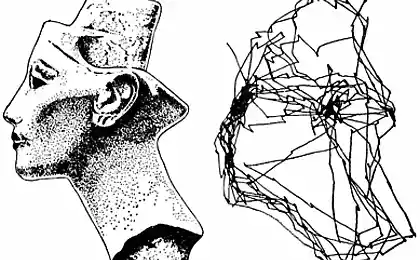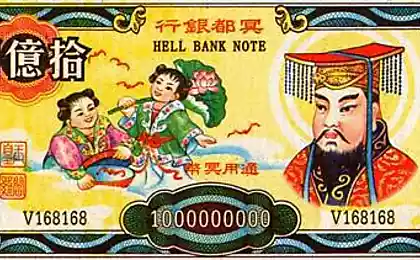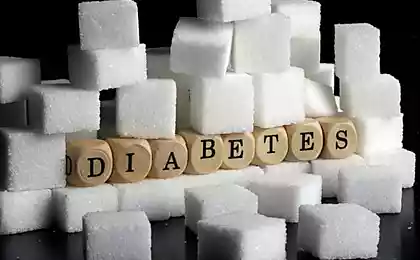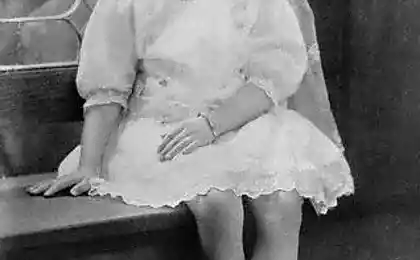1241
10 most fascinating descriptions of hell
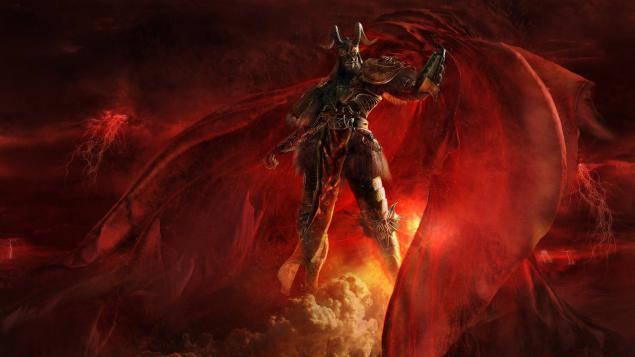
Almost every culture or religion in the world describes the existence of a kind of underworld, or Hell. These descriptions are often unusual in how they define the sinners and what penalties are assigned for their sins. While each of the explanation is unique in its own way, there are elements that are common to many cultures and religions.
10. Niflheimr
Niflheim is a rather peculiar idea of hell in the Nordic and Germanic cultures. And it is not the land of fire and ice and fog, which is ruled by Hel, and which is located close to the shore of corpses, where he lives Nidhogg. Nidhogg is a giant snake, eats dead. Of the nine worlds of Nordic-Germanic mythology, Niflheim is the deepest and darkest of all, the myths say that the Earth was created when land ice Niflheim and fiery Muspelheim came together. This kingdom is home to sinners, and also serves as an anchor Yggdrasil - the World Tree, which is holding the universe. Hel was the lady dead after was banished from Asgard, as the daughter of Loki. Soul trapped in Niflheim due messenger Hela Hermodru experiencing constant pain.
9. Tuonela
Pre-Christian tribes of Finns believed that the souls of the dead came to the banks of the river Tuon and then transferred to a Tuonelu servant Death, Tutti. Unlike most other underground worlds in this list, Tuonela was largely grim continuation of life on Earth. Those heading to Tuonelu had to bring along any things to survive there. There was even allowed to receive visitors who wish to visit their deceased relatives, although this trip was dangerous and often deadly. Especially dangerous is the river on the way Tuon, which was filled with poisonous snakes. No real punishment is prescribed in Tuonele, except that your life becomes eternal.
8. House of lies (Zoroastrianism)
According to the Zoroastrian religion, the first thing that meets the soul after death - Shinawatra bridge that separates the world of the living and the dead. Bridge thinner hair, but a sharp blade, and is guarded by two dogs chetyrehglazogo. Souls are then evaluated on the basis of deeds in life. If bad things done more than good, the bridge appears on the one hand, taking the soul into the underworld. Alternative descriptions indicate Vizareshe - demon that appears in this grave, and takes a cruel soul in House of Lies - Zoroastrian version of hell. House of Lies is described as a disgusting abomination place where people fed spoiled food and constantly subjected to tortures for their actions. Demons House of Lies hundreds, and each represents a specific sin. For example, Apaosha is a demon of drought and thirst, while Zairika is a demon that makes poisons. Description House of Lies will vary depending on the translation of the ancient Zoroastrian texts, but the elements described above are the same for all descriptions.
7. Duat (Egypt)
In the ancient Egyptian funerary texts described the afterlife, known as the Duat, led by Osiris, god of the dead. The inscriptions also contain a map depicting the route in the Duat. They also described the kingdom, like the Earth, but contains mystical elements such as the lake of fire and iron walls. When approaching Duato soul had to pass through the gate, half-animal, half human protected. After passing through the gate of the heart of the deceased was weighed against a feather. If the heart was heavier than the feather, it was soon eaten by a demon Ammutom. Then the souls of sinners are brought to justice in Duat. Many were then forced to walk upside down or biting and devouring a snake demon.
6. Hell
The name "Hell" originally referred to a valley near Jerusalem, where the followers of the god Moloch brought him as a sacrifice of children by burning. Then it was the interpretation of the Hebrew name of hell where sinners sent to repay for his sins. Hell reflects the Christian version of Hell is more accurate than most other places in the list. Needless kingdom was a description of the deep and lonely places where continuous burning fire and there was a rain. The heat emanating from the fire was 60 times hotter than any flame found on Earth. Poisonous gases sulfur hung in the air and on the rivers flowed molten metal.
5. Tartar
Found in Greek and Roman mythology, Tartarus is described as a deep dark dungeon full of torture and suffering. While most believe the kingdom of Hades hell, in fact, this is the place for all the dead, and the tartar was even deeper and meant only for sinners. People went to Tartarus after a meeting with the judge Rhadamanthus, who appointed his sentence. In Roman mythology, Tartarus is surrounded by three walls and a river of fire Phlegethon. He is guarded by a monster with nine heads known as Hydra and Tisiphone which oversees all, and constantly hit people whip from his post. At the bottom of Tartarus, the Titans are the enemies of the gods, who were defeated and imprisoned. Similarly, in Greek mythology, Tartarus is described as a place that at first it was a prison for those who would be a threat to the gods, but later began to function as hell for all sinners. Sinful souls give punishment corresponding to their sins. For example, tantalum was exiled to Tartarus after killed his son Pelops, prepared a dish of its meat and gave it to the gods feasting. For this he was punished with eternal suffering of hunger and thirst while standing in water, which could not drink, and a fruit that could not eat.
4. Dante's Inferno
Many popular Christian concept of hell can be traced in the poetry of the Renaissance poet Dante Alighieri. His "Divine Comedy" describes the allegorical journey across the sky, purgatory and hell. Hell begins with a sublayer where people are doomed to stay, as did not do anything in life. They punished the fact that ever pursue their personal interests, while they pursue a swarm of insects and wasp sting. Known as Acheron River, bordering nine circles of hell. The first round is quite a pleasant place called Limbo, which is home to non-Christian souls who did not commit sin. The rest of the circle corresponds to each of the seven deadly sins. On the second lap lust twist and torture punishable by a hurricane. Third round - a home for gluttons and gourmets, who are forced to be in the disgusting slime. The fourth circle of hell contained two groups of sinners: those who saved his money, and those who spend them, and now they have to fight endlessly with each other. Those who commit sins of anger, still on the fifth lap, where fighting with each other in the river Styx, and they are no longer able to ever feel happy. At the sixth level of the heretics are locked in a blazing hot fire coffins. The seventh circle is divided into sub-levels for the perpetrators of the neighbors, suicide and rapists of nature or God. Eighth circle for fraudsters and divided into sub-levels where sinners fetters in the rock upside down by their feet flowing fire, their heads turned by a half-turn, they whip rods immersed in feces and boiling lake and a snake bite. The last circle is home to those who have committed treason against their native relatives, friends, and for that they are doomed to be chained to the ice on his neck. In the center of hell - Satan himself, who personally punish the most horrible sinners and traitors, he always chews body Cassius, Brutus and Judas.
3. Naraka
Naraka or Nirayya is a concept of hell for certain branches of Hinduism, Sikhism, Jainism and Buddhism. Although the exact description of Naraku differ among religions, it is a place of punishment based on the karma of the soul. Naraka is only a temporary place of sinners and once paid for his karma, they are reborn. It is believed that it can be divided into several levels, depending on the sins committed during life. The number of levels in Naraka vary from four to more than 1000, depending on the various descriptions. For example, Maharaurava - a place for those who live at the expense of others. In Maharaurava eaten the flesh of the sinner demon Ruru. But Kumbhipaka is home for sinners who eat birds and animals. As punishment, they are cooked in hot oil during the same time as the hair was on the animals they killed. In the Hindu and Jain cultures kingdom Naraka Yama Loka controls, the God of justice. When a person dies, his actions during the life of Locke assistant checked, then this person is sent or Svarga (paradise) or Naraku. Unlike Hinduism or Jainism, the Buddhists believe that all souls go to Naraku to be cleansed of their sins, and there is no single ruler who would take into account the actions of people in their lives. Regardless of these cultural differences, it is believed that the soul can remain in Narake for billions of years, and while it will not reverse the karma, the soul can not be revived.
2. diyu
Diyu is a version of hell in the traditional Chinese culture and vaguely reminiscent of Naraku. This kingdom consists of several levels, with the exact number differs from four to eighteen. For each level, there is a judge, and the punishment of sinners depend on their actions during their lifetime. The Chinese culture believes that Pit Loki from Naraku is designed to monitor and diyu where he eventually divided the 96, 816 Hells 10 levels that sinners had to undergo before their souls could be reborn. During the Tang Dynasty is the description changed to hell 134 18 levels of pain and torture. The most common description of the levels includes a room of scissors, a room with zerkalom, Mount knives, ice hill, a cauldron of boiling oil, a room with a buffalo, with a puddle of blood, City of suicide, room partition, Mountain of Fire, and the room saw. Worst level of hell known as Avici, which is designed for the greatest sinners. Avici is different from the other levels of the kingdom diyu that the soul is ultimately remain forever without more hope reborn.
1. Xibalba
Xibalba is the name of hell at the Mayan and is believed to actually exist as a physical place in the caves near Belize. It says it is a place of pain, where the lord of the afterlife staged various forms of torture the souls got there. Masters worked together to punish the visitors Xibalba. Ah-ah-alpuh and Algan forced pus oozing from the bodies of people. Hamiabak and Hamiaholom cause decomposition of the bodies of the dead skeletons. Ah-ah-almez and altokob and worked almost as well as in advertising Meyhem Allstate, causing a deadly scourge in people's homes. Hick Patan and caused the death of people on the road, or causing them to vomit blood or squeezing so until blood filled their throats. Showers were forced to go through a difficult and humiliating way just to reach Xibalba. Their journey begins at the intersection of several rivers, filled with blood, pus, and scorpions. From there, the path divided into four roads, intended to entertain rulers who humiliated and confused travelers. Visitors to further checks were heading to one of the six houses of death: heat House, House jaguar house bat (driven by Socialist Kama, the god in the form of a bat vampire), House of obsidian knives and House of darkness. Last house, known as the House of the cold, was showered with hail and all the time it was a low temperature.
Experience the order in Chinese Internet stores
All the heroes of books about Winnie the Pooh have pronounced mental disorders
